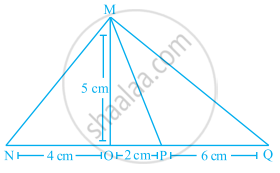Advertisements
Advertisements
Question
The four vertices of a quadrilateral are (1, 2), (−5, 6), (7, −4) and (k, −2) taken in order. If the area of the quadrilateral is zero, find the value of k.
Solution
GIVEN: The four vertices of quadrilateral are (1, 2), (−5, 6), (7, −4) and D (k, −2) taken in order. If the area of the quadrilateral is zero
TO FIND: value of k
PROOF: Let four vertices of quadrilateral are A (1, 2) and B (−5, 6) and C (7, −4) and D (k, −2)
We know area of triangle formed by three points (x1, y1),(x2, y2) and (x3, y3)is given by
`Δ =1/2[x_1(y_2 -y_3)+x_2(y_3-y_1)+x_3(y_1-y_2)`]
Δ`=1/2[x_1y_2+x_2y_3+x_3y_3)]`
NOW AREA OF ΔABC
Taking three point when A(1,2) and B (-5,6) and C (7,-4)
Area (ΔABC)
`=1/2[{6+20+14}-{-10+42-4}`
`=1/2[{40}-{28}]`
`=1/2[{12}]`
Area (ΔABC) =6 sq.units
Also,
Now Area of ΔACD
Taking three points when A (1, 2) and C (7, −4) and D (k, −2)
`=1/2[{-4-14+2k}-{14-4k-2}`
`=1/2[{2k-18}-{12-4k}`
`=1/2[{6k-30}]`
`=[{3k-15}]`
Hence
Area (ABCD) = Area (ΔABC) + Area (ΔACD)
`0=6+3k-15` (substituting the value )
`k=3`
APPEARS IN
RELATED QUESTIONS
Find the area of the triangle ABC with A(1, −4) and mid-points of sides through A being (2, −1) and (0, −1).
Find the area of the triangle whose vertices are: (2, 3), (-1, 0), (2, -4)
Find equation of line joining (1, 2) and (3, 6) using the determinant.
The area of a triangle is 5. Two of its vertices are (2, 1) and (3, −2). The third vertex lies on y = x + 3. Find the third vertex.
Find the area of a triangle two sides of which are 18 cm and 10 cm and the perimeter is 42cm ?
Find the value(s) of p for which the points (3p + 1, p), (p + 2, p – 5) and (p + 1, –p) are collinear ?
Find the value(s) of k so that the quadratic equation x2 − 4kx + k = 0 has equal roots.
The table given below contains some measures of the right angled triangle. Find the unknown values.
| Base | Height | Area |
| 20 cm | 40 cm | ? |
Let ∆ = `|("A"x, x^2, 1),("B"y, y^2, 1),("C"z, z^2, 1)|`and ∆1 = `|("A", "B", "C"),(x, y, z),(zy, zx, xy)|`, then ______.
Ratio of areas of ∆MNO, ∆MOP and ∆MPQ in the given figure is ______.

